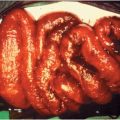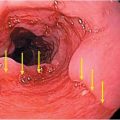Bacterial |
Routine culture and Gram stain |
|
|
Bacillus anthracis (anthrax) |
Gram (+) rod, biopsy for immunohistochemistry and PCR |
Wool handler; Western Asia, West Africa, Eastern Europe; injection drug users (heroin); potential bioweapon |
Lesions on face and arms; painless papule develops into vesicle that dries, forming black eschar that then separates from the base to form an ulcer with marked surrounding gelatinous edema; LN common; injectional anthrax – higher mortality and shock, significant edema |
Corynebacterium diphtheriae (diphtheria) |
Gram (+) rod |
Tropical climates; rare in the United States |
Ulcer with sharp margins and clean base; pre-existing skin lesions may become infected |
Francisella tularensis (tularemia) |
Gram (–) coccobacillus, serology |
Rabbits, muskrats, beavers; North America, Japan, Europe, former Soviet Union; potential bioweapon |
Systemic febrile illness; tender ulcer with painful LN |
Nocardia spp. |
Branching, beaded gram (+) rod, modified AFB (+) |
Immunocompromised patients, soil exposure |
Ulcer with purulent drainage, nodular lymphangitis |
Pseudomonas aeruginosa (ecthyma gangrenosum) |
Gram (–) rod, may have associated bacteremia |
Neutropenic or immunocompromised patients |
Rapidly progressive eruption from papules to hemorrhagic vesicles or bullae that undergo central necrosis and ulceration |
Polymicrobial |
Mixed gram (+), gram (–), and anaerobes |
Debilitated, immunocompromised, diabetic patients |
Pressure sores, decubitus ulcers, foot ulcers |
Yersinia pestis (plague) |
Gram (–) coccobacillus, bipolar-staining “safety pin” morphology, serology |
Rodent zoonosis transmitted to humans via fleas; Far East, India, Africa, Central and South America, potential bioweapon |
Bubonic plague with classic inguinal painful LN; may have skin lesions on lower extremities; pustule, papule, vesicle, or eschar may occur at inoculation site |
Spirochetes |
Treponema pallidum (syphilis) |
Serology |
Sexually transmitted disease |
Tertiary syphilis; nodular, ulceronodular, gummas; punched-out ulcer with gummy discharge |
Fungal |
Fungal smear, culture |
|
|
Aspergillus spp. |
Septate hyphae; serum galactomannan assay in high risk patients |
Immunocompromised, HIV positive |
Ulcers, plaques, nodules, pustules; may be associated with trauma, intravenous catheter sites, secondary colonization of existing wounds, or direct extension from lung to chest wall |
Blastomyces dermatitidis |
Broad-based budding yeast, dimorphic fungus |
Sugar cane worker, HIV positive, immunocompromised; North America, Africa |
Subcutaneous nodule that enlarges and ulcerates, forming a crusted, verrucous plaque; may resemble squamous cell carcinoma |
Coccidioides immitis |
Dimorphic fungus, serology |
Soil exposure, HIV positive; Southwestern United States, Northern Mexico, Central and South America |
Usually single nodule or plaque; may form pustules, subcutaneous nodules, or abscesses |
Cryptococcus neoformans |
India ink, encapsulated yeast, mucicarmine (+) capsule, cryptococcal antigen (serum and CSF) |
Exposure to pigeons, soil exposure, HIV positive, immunocompromised |
Papule with crust resembling molluscum contagiosum; also forms ulcers on skin, mouth, and genitalia; may have lung or CNS involvement |
Histoplasma capsulatum |
Dimorphic fungus, histoplasma antigen (urine and serum) |
Bats, birds, and soil exposure; HIV positive, immunocompromised; Eastern and Central United States in Ohio/Mississippi river valleys, Central and South America, West Indies, Africa, Madagascar |
Papule with crust resembling molluscum contagiosum; ulcerative plaques and oral ulcerations |
Sporothrix schenckii |
Dimorphic fungus |
Rose gardening, soil exposure |
Papule or pustule at inoculation site develops into subcutaneous nodules or ragged-edged ulcer with proximal nodular lymphangitis; usually on upper extremities |
Mycobacterial |
AFB smear, culture |
|
|
Mycobacterium marinum |
AFB (+), growth at 30–32°C |
Water, aquarium enthusiasts |
Ulcer with thin seropurulent drainage, nodular lymphangitis |
Mycobacterium ulcerans (Buruli ulcer) |
AFB (+), PCR for the insertion sequence IS2404 and IS2606 in swabs or tissue samples |
Africa, Australia, South East Asia, South America, North America (Mexico); 2- to 3-month incubation period, usually associated with trauma |
Subcutaneous nodule that ulcerates with extensive scarring and contracture formation; edematous lesion rapidly progresses to extensive ulceration, may have osteomyelitis contiguous to ulcer |
Mycobacterium avium complex |
AFB (+) |
HIV positive, immunocompromised; soil, water |
Multiple subcutaneous nodules or ulcers; may be associated with cervical lymphadenitis drainage to skin, or direct inoculation |
Mycobacterium haemophilum |
AFB (+), requires iron-supplemented culture medium and incubation at 30–32°C |
Australia, United States, Canada, France, Germany, Singapore; HIV positive, transplantation |
Papules develop into pustules which form deep ulcers, usually on extremities overlying joints; may have septic arthritis +/– osteomyelitis, may have LN |
Mycobacterium tuberculosis |
AFB (+), PPD or interferon-γ release assay helpful if positive |
Worldwide |
Nodules or ulcers especially in HIV-positive patients, scrofuloderma, plaques |
Viral |
Herpes simplex |
DFA, viral culture |
Sexually transmitted disease |
Oral, perineal, genital ulcers; whitlow on hands; lesions with thin-walled vesicles; shallow painful ulcers |
Parasitic |
Leishmaniasis |
Punch biopsy, aspirates, or scrapings of skin for culture, histopathology and touch prep using Wright’s and Giemsa stains looking for amastigotes at base of lesion; serology; PCR of tissue aspirates or peripheral blood |
Sandfly bites, travel to endemic area (military or civilian); incubation period weeks to months |
Papule at the site of insect bite enlarges to form a nodule, which then develops into a punched-out ulcer; may have associated LN; rarely nodules form without ulceration; may involve nasal or oral mucosa |
Old World
L. major
L. tropica
L. (L.) aethiopica |
|
Mediterranean, Middle East, Africa, Southern Asia, India |
|
New World
L. mexicana complex
Viannia subgenus:
L. (V.) braziliensis
L. (V.) panamensis
L. (V.) guanensis
L. (V.) peruviana |
|
Latin America, Central and South America |
|






